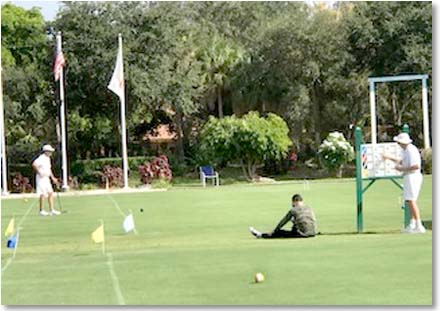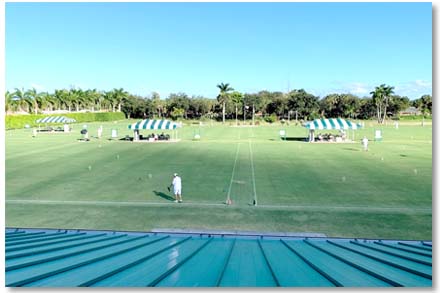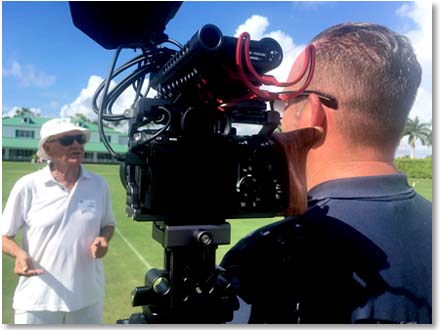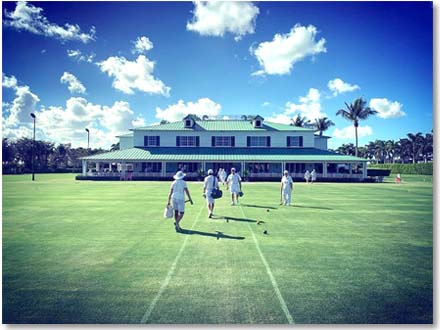

|
Back to |
| The Front Page |
| News & Features |

|
The day the movie people came Part One, Florida |
||||||
|
By Bob Alman Photos by Zach Guerra, Brian O'Hare, Bob van Tassel and Nanci Hunt
Layout by Reuben Edwards
|
||||||
|
||||||
Your editor expects to hear from the mainstream press--including television and films--when they search the Web and find CROQUET WORLD referenced as "the global, independent voice of the sport." But that's not what happened in this case. Hal Denton of the Croquet Foundation of America hosted Brian O'Hare and Zach Guerra in Maryland when they were filming at St. Johns and Annapolis. They asked him if there might be anyone they should interview at the USCA's headquarters in Florida who was "colorful and interesting." "Yes, he said. "Bob Alman." When they called, I told them that although I am accustomed to doing PR for croquet, I'm not really representative of the sport, in my 80th year. They persisted and I surrendered to the inevitable. From our online masthead, they got James Hawkins' contact information as European editor, called him, and asked him to show them the British headquarters at Cheltenham. That will be Part Two.
Even in America, in the age of "fake news," we still take the media seriously. Sometimes, when we are asked to give them information, the spin we give it serves their own ends as well as ours. The producer and director of this particular film told me the main subject was the biggest croquet event in the world. I knew before they said anything more that they were talking about the annual croquet bash between the navy guys at Annapolis and nearby St. Johns, now in its 30-somethingth year.
| The Annapolis Cup |
|
More than 7,000 spectators attended last year's games between the Naval Academy and St. John's. According to Zach and Brian, the annual croquet grudge match is a story with implications reaching far beyond a "silly" croquet match; it's a great sports rivalry, and it mirrors a nation in crisis, torn into "Red" and "Blue". The U.S. Naval Academy, with just over 4000 Midshipmen, is considered the premiere military academy in the world. St. John's College, just over 400 students, is widely regarded as one of the best liberal arts colleges in the world. The croquet games are a combination of 9-wicket and 6-wicket rules, played on long grass in a single day. Since its inception in 1983, the Johnnies have beaten the Midshipmen 28 out of 35 times. How liberal arts students should have compiled a 28-7 record against disciplined military folk is a mystery explained in different ways on opposite sides of the street that separates the two institutions.
|
Of course they knew that annual event isn't the sport as practiced at its highest level--but it looks especially big and impressive through the camera lens, with a cast of thousands. They started working on this project more than three years ago, fitting it in between shoots for advertisements and other projects that provide them with capital. Once they get footage from the British HQ of the sport, they'll be ready to put the entire thing together.
It's called "CANNON SHOT," and their teaser looks very impressive, indeed.

|
| Bob van Tassell is not playing, but somehow he winds up as the seated focal point in this Guerra snapshot of the NCC veranda. The photos taken by the movie guys on their scouting day at the Center were not shot for content, but to orient themselves to the entire facility in preparation for shooting the next day. |

|
| On scouting day, Bob Alman points south: Should he show the film guys the maintenance shed? McCoy is credited with saving the Center, as president of the Croquet Foundation of America. Guerra photo. |
The ideal contrast might be a serious tournament of elderly folks dressed in whites, played over many days on perfectly flat and smooth short grass on regulation courts, with "professional" equipment in an elegant setting.
As luck would have it, they planned their visit to the National Croquet Center for the beginning of the USCA's virtual season-opener--the Seniors and Masters championships (for players 60 and older). I have to believe that they didn't plan it that way, it was just "lucky" for them--if they're seeking the ultimate contrast needed to the boisterous display of youthful energy up north.

|
| The on-court shadows indicate that it's close to midday, as Nanci Hunt and her friend approach the east veranda. Zach Guerra photo. |

|
| Zach scopes out the veranda for shooting spectators. Van Tassell photo. |
I actually did have fun. I volunteered to be their "gopher" and showed them all the best places to shoot from at the Center on their scouting visit in the afternoon of Wednesday, and I introduced them to the principals at the Center--the manager, Marie Sweetzer, CFA president David McCoy, (still competing in his 80th year), Vicki in the Pro Shop (where Zach bought a hat) and resident pro, David Bent. David Bent is in very good shape, and as a frequent member of USCA international teams, could surely represent to them the highest standards of play in the sport.

|
| Producer Brian O'Hare finds a good angle and perfect light for shooting play in progress. Van Tassell photo. |
| How the movie makers met |
|
It was in 2008 at an Army/Navy football game party in Los Angeles. Waxing poetic about all things film and the Naval Academy they discovered they both had good taste in movies, so they stayed in touch while Zach was still attending USCís MFA film program. When Zach had to make a decision about a thesis film, he asked Brian to produce it. Never having produced before, Brian jumped in feet first. They've been working together ever since on commercials, branded content, and now feature films. They don't always work together--such is the industry--but this project has occupied their attention for more than three years, testing their film making mettle. They consider themselves better people and better friends for having lasted this long and dedicated themselves to telling a story not many people thought was there. As they approach the end of their filming and see the story coming into focus for more and more people, they've begun to enjoy the results of their hard work. Their working partnership looks both seamless and effortless. |

|
| The guys found the perfect spot from which to shoot the players in action and stage filmed interviews. Nanci Hunt photo. |
They took lots of snapshots on their scouting day, and told me they would share them with me for this article. I enlisted a couple of friends to take a few pics as well, of the movie crew in action.

|
| Photographers always like to shoot from the second floor, but the film makers didn't like the roof in the foreground. Center manager Marie Sweetzer told them they could go out on the metal roof and shoot, so that's what they did, the next day. Guerra photo. |

|
| With a special lens, Zach Guerra manages to capture at least part of eight of the twelve courts in one photo, snapped in the morning of the Thursday film shoot. |
The surface of the dry retention area was dotted with little white flowers that come up almost overnight, so I asked if I should get it cut. They said YES, and Marie Sweetzer issued the order. But as it turned out, they didn't film at all from the dry retention area. Instead, after lots of fiddling with equipment, they set up in front of the flags on the east side of the regulation courts, an ideal spot from which to film all the croquet around them on the main courts.
| The filmmaker's nomadic life |
|
One of the things Brian and I both appreciate is the nomadic experiences of the filmmaker. The military promised a life of travel and experience--which we both got a lot of--though youíre not always going to the places you want, or having the experiences you think you would chose. In film making you get opportunities to meet some very interesting people and go to places--like the National Croquet Center--that we would have not otherwise gone to. We hope with this film we can do the same for people who would have never given the NCC or the sport a second look, or thought that itís just full of stuffy rich white folk. The management of the Center have done an excellent job of making the sport of croquet relateable and less intimidating. And why would we ever think of exploring croquet in England, if not for this project? - Zachary Guerra |

|
| This photo of Bob Alman happens to be perfectly centered-- by Zach Guerra, director of the Cannon Shot film. |
Those games would also be the backdrop of a long interview with Bob Alman that began late in the morning. After fitting me with the microphone, Brian told me he would be standing by as Zach interviewed me, and showed me some signals he might give me to indicate "Yes, more of that" or "Enough of that, move on," and the like. They told me frankly that they were looking for "gold" as sound bytes.

|
| The film producer, Brian O'Hare, who snapped this one, had shown Bob some hand signals he might use to show when to elaborate, when to move on, and so forth. Bob doesn't recall seeing any of those signals. |
They told me later that I actually delivered the "gold" they need for this flick. I assume they meant by that the extreme measure of contrast needed in a film centered on college students. We shall see.

|
| The NCC pro Dave Bent, is in the background, is retrieving a ball. Dave offered the film's director, Zach Guerra, a game of Golf Croquet, while producer Brian O'Hare manned the camera. |
They are certain the film will be released by next summer. We will of course trumpet that release--which should get a respectable circulation in the croquet world, as we plan to have completed the initial phase of the redesign and expansion of CROQUET WORLD by that time. The new editor, James Hawkins, shall have begun to take over the global tasks of editor which founder Bob Alman has held on for too long, while Bob--if he is still among the living--will continue to produce American content.

|
| Zach turned out to have the focus and concentration first-time players need to excel in croquet. Bob told him he also has the perfect body type for the sport. Here, he doesn't hesitate to imitate fairly closely a long jump shot Dave had demonstrated in their game. Brian O'Hare photo. |
One thing is certain: James Hawkins is going to look a lot more youthful--at the age of 50--than Bob does at 79. But Hawkins' speech sounds very English, so when they visit Chelteham--the British seat of the sport--they'll find plenty of contrasts to the American croquet scene. They're even likely to see some players there under fifty playing serious croquet--if it isn't raining too hard.

|
| Near the end of the playing day, competitors leave the courts. Guerra photo. |
The documentary will be about 80 minutes long when it's completed. Zach and Brian have been all over the US filming more than 60 interviews, from San Francisco where they spoke to Ben Rothman, to Los Angeles, San Diego, Santa Fe, Austin, Annapolis, Baltimore, Washington, D.C., Virginia, and West Palm Beach. The filming will end in the United Kingdom in 2018. Readers who want to catch the film in theaters in 2019 should tune into www.cannonshotdoc.com.
They expect the film to be available on a streaming service such as Amazon or Netflex by the summer or fall of 2019.